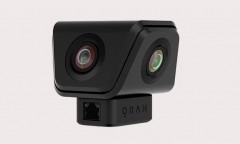By Steve Pak, | April 13, 2016

Impossible Project's I-1 Camera
Kodak's Polaroid cameras will get an upgrade in Impossible Project's instant camera. The photo-printing model named I-1 works like old-school Polaroid cameras but uses Bluetooth connectivity to connect with an iOS app for snapping a photo remotely and changing the device's shutter speed and smart flash. It also uses a USB stick to juice up the rechargeable camera battery.
Like Us on Facebook
Setting up the I-1 camera for capturing photos is easy. Users just have to pop in a film cartridge, take a photograph, then wait for the blank photo paper to magically develop into a colorful picture.
After camera owners tweak the I-1's settings they can take a shot and print images using reverse-engineered type 600 films, according to Engadget. People who have discontinued Polaroid film stored somewhere in a drawer or cabinet can use it in the I-1 unit.
The digital camera's lens includes a round flash that includes a ring of LEDs that can automatically change its intensity based on the surrounding light and distance from the subject.
Photographers can use some fun tricks to take instant photos with the I-1, including double exposures and light streak shots. A set of eight instant photos will cost $24.
Impossible Project has also developed other products in the past. They include type 600 film and a crowdfunded device called Instant Lab that can print photos captured by mobile devices.
The I-1 camera will have a price tag of $300 and ship on May 10, according to Gizmodo. It is a cheaper option than the Fujifilm Instax.
In related news, the world's first virtual reality surgery will be broadcast during this week. Dr. Shafi Ahmed is an Apple Watch-wearing physician who uses a Polaroid instant camera to snap pictures of each new trainee surgeon. The cancer specialist will soon conduct the first VR surgery that will be live-streamed using a 360-degree camera rig that captures 4K resolution video.
Here's how a Polaroid camera works:
People can watch the two-hour surgery by using a mobile app and Google Cardboard headset. The video stream will get a one-minute delay in case something goes wrong during the low-risk procedure. Ahmed explains that the patient is supporting how the surgical team is teaching medical techniques throughout the world.
-
Use of Coronavirus Pandemic Drones Raises Privacy Concerns: Drones Spread Fear, Local Officials Say

-
Coronavirus Hampers The Delivery Of Lockheed Martin F-35 Stealth Fighters For 2020

-
Instagram Speeds Up Plans to Add Account Memorialization Feature Due to COVID-19 Deaths

-
NASA: Perseverance Plans to Bring 'Mars Rock' to Earth in 2031

-
600 Dead And 3,000 In The Hospital as Iranians Believed Drinking High-Concentrations of Alcohol Can Cure The Coronavirus

-
600 Dead And 3,000 In The Hospital as Iranians Believed Drinking High-Concentrations of Alcohol Can Cure The Coronavirus

-
COVID-19: Doctors, Nurses Use Virtual Reality to Learn New Skills in Treating Coronavirus Patients










